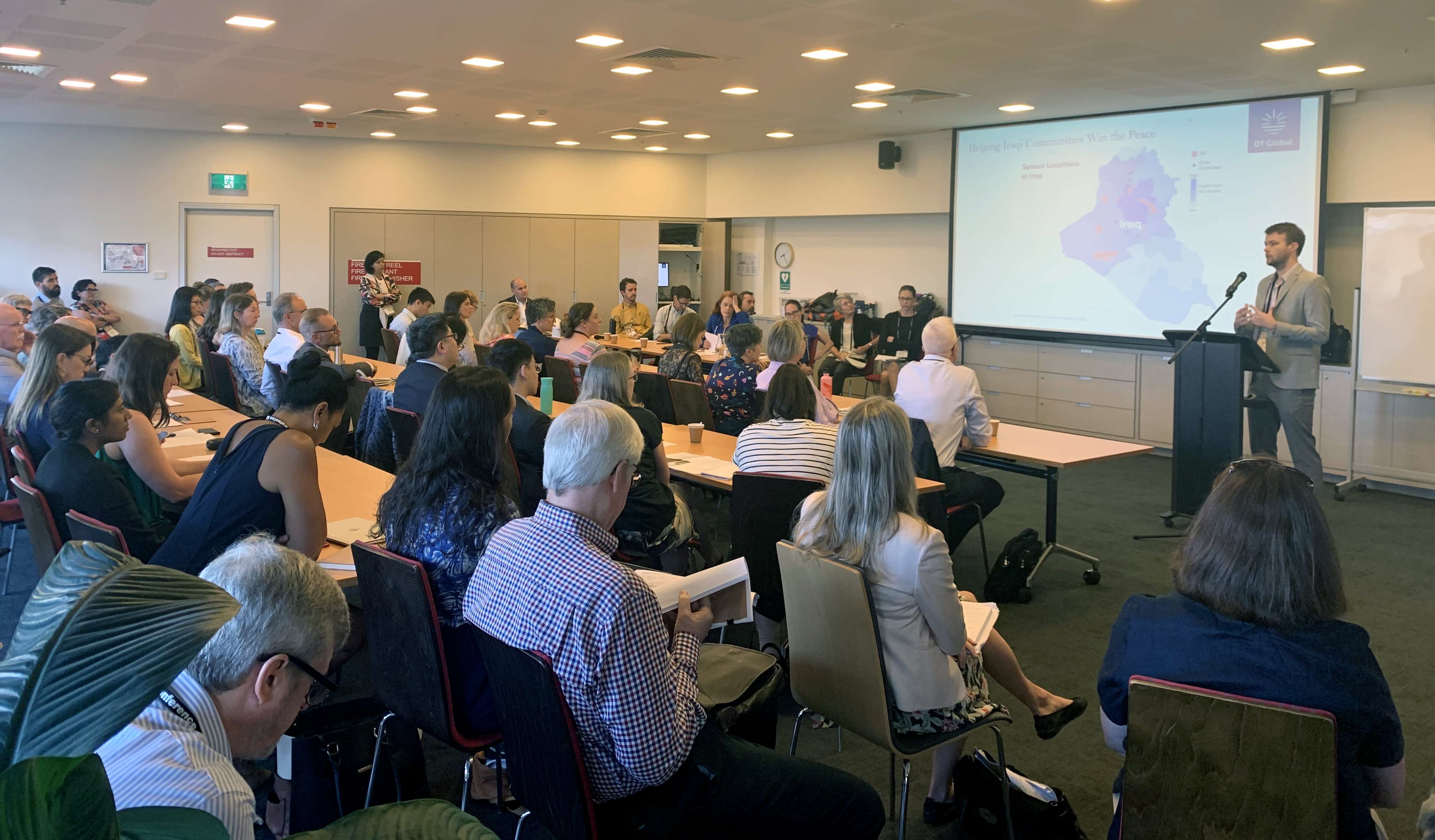
Bringing together international development researchers and practitioners from across the globe, the 2020 Australasian AID Conference brought to light insights across a range of topics, from health to innovative financing; rethinking civil society approaches to designing effective aid. DT Global was proud to sponsor the conference and send five of its staff to participate in three panels: Sloan Mann and Orion Wilcox on the Aid Effectiveness panel; Mel Dunn on the Technology in Development Practice panel; and Steve Knapp and Sandra Mendez, staff on the Business Link Pacific Program funded by New Zealand Aid and implemented by DT Global, on the Private Sector panel.
The conference highlighted a number of trends across the development industry. Keynote speaker Jonathan Glennie, a visiting fellow at King’s College London, took the 30,000-foot view of the aid industry, challenging attendees to move from an aid industry based on “rich countries giving to poor countries” to one in which “everyone has a seat at the table” in confronting global challenges. Over the course of three days, panelists from dozens of countries and fields discussed how aid practitioners are putting this vision into practice, while highlighting the challenges that lay ahead.
Key themes of the conference included the shift away from top-down program design toward more participatory approaches, such as human-centered design, the need to take a page from the world of Silicon Valley to use behavioral insights in development programs, and a renewed focus on (and healthy skepticism toward) the role of technology in development.
In a panel on Aid Effectiveness Methods, panelists discussed the challenges of providing real opportunities for local participation in the design and evaluation of development programs, including the need to move away from traditional log frames. Sloan Mann and Orion Wilcox presented DT Global’s Sensus methodology as one answer to this challenge. Through Sensus, DT Global engages local partners throughout the entire program cycle, from design to the selection of monitoring and evaluation indicators, all the way to final program assessment. You can read more about Sensus here.
While local participation is a necessary component of good development practice, panelists pointed out that it is, by itself, insufficient. Emerging research in behavioral economics indicates that, contrary to traditional economic theory, individuals do not always act purely in their own “self-interest.” This means that simply asking local communities “what they want” may not always lead to satisfactory outcomes. Instead, development practitioners need to lean on new findings from the worlds of psychology, anthropology, and user research to understand why beneficiaries (i.e. customers), behave the way they do under different circumstances.
For example, DT Global’s partner on Pacific Island Food Revolution (PIFR) program, the Busara Center for Behavioral Economics, presented on how they are using behavioral science techniques to improve healthy eating habits in Pacific Island countries. PIFR is a communication for development program jointly funded by the Governments of Australia and New Zealand and as part of it, Busara conducted a lab study to gauge the impact of the PIFR reality TV cooking competition show on dietary choices.
The study, which involved 800 students, found that watching a compilation of PIFR TV clips significantly increased the likelihood that female students chose a healthy, Pacific meal, as opposed to an unhealthy foreign option. In contrast, the clips had no effect on men’s choices and no meaningful effect on either men’s or women’s perceptions of Pacific food. Next, the program conducted surveys across four countries (Fiji, Samoa, Tonga, and Vanuatu) to gauge if food choices and perceptions of Pacific food changed over the PIFR TV show airing period. In those surveys results, we saw a shift in positive perception of local food affordability and availability, and also saw that respondents considered their local food to be healthier than foreign food.
Many of the new approaches highlighted at the conference rely on technology. But as many panelists pointed out, technology is only one part of the equation—and likely not the central part. “In the future, I would hope we wouldn’t have a panel called Technology in Development,” said David Roach, Director and Co-Founder of Catalpa International, a design and technology firm based in Timor Leste. “As all development programs rely on technology, we need to focus on just doing good development that uses technology,” he added.
Catalpa, which received early stage funding from DFAT under the Innovation Resource Facility (IRF) managed by DT Global, presented on its mHealth (read mobile health) application designed to improve maternal health outcomes. While Catalpa develops software, Roach believes the key to the program lies in its use of human-centered design. The application emphasizes building relationships between patients and nurses by providing a chat option and sending patients reminders of upcoming appointments. Mothers who used the app were more than two times as likely to deliver their child in a hospital and five times as likely to attend follow-up care, according to Catalpa.
At DT Global, we’re excited to be contributing to the evolving body of knowledge in international development. In 2020, we look forward to applying what we learned at the Australasian AID Conference to our programs across the globe.